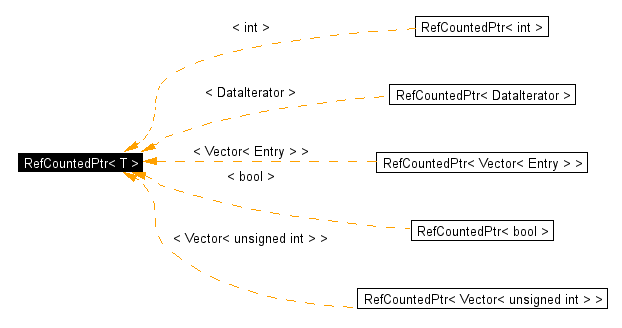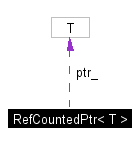
#include <RefCountedPtr.H>
Inheritance diagram for RefCountedPtr< T >:


Public Member Functions | |
| RefCountedPtr (T *ptr=0) | |
| RefCountedPtr (const RefCountedPtr< T > &other) | |
| ~RefCountedPtr () | |
| const RefCountedPtr< T > & | operator= (const RefCountedPtr< T > &rhs) |
| assignement operator. copies pointer member | |
| T * | operator-> () |
| dereference access operator. use like a pointer derefence access function. | |
| const T * | operator-> () const |
| bool | isNull () const |
| T & | operator * () |
| pointer dereference. | |
| const T & | operator * () const |
| operator const T * () const | |
| auto conversion to regular const pointer where required. | |
| bool | isNonUnique () const |
| true when refcount is one. | |
| int | refCount () const |
Protected Attributes | |
| T * | ptr_ |
| int * | refCount_ |
This is to be used as a pointer to class T. This will feel and smell just like a built-in pointer except:
This class is completely inlined.
typical usage:
{
Box b;
IntVect a;
//refCount() == 1
RefCounterPtr<IntVectSet> set(new IntVectSet());
// still just one IntVectSet, but refCount()==2
RefCountedPtr<IntVectSet> otherSet(set);
// Like a pointer, modifying one modifies the other
otherSet->define(b);
(*set)|=a;
{
RefCountedPtr<IntVectSet> anotherSet; // null
anotherSet = otherSet ; //now all three have refCount()==3
}//anotherSet out of scope, so deleted. IntVectSet NOT deleted.
// set.refCount() == 2
// otherSet.refCount() == 2;
// otherset == set;
}
// when all RefCountedPtr's for a given object are deleted, the last
// one calls 'delete' on the member pointer.
|
||||||||||
|
|
|
||||||||||
|
|
|
|||||||||
|
|
|
|||||||||
|
true when refcount is one.
|
|
|||||||||
|
|
|
|||||||||
|
|
|
|||||||||
|
pointer dereference.
|
|
|||||||||
|
auto conversion to regular const pointer where required.
|
|
|||||||||
|
|
|
|||||||||
|
dereference access operator. use like a pointer derefence access function.
|
|
||||||||||
|
assignement operator. copies pointer member copies pointer member and integer pointer, decreases refcount of rhs member before assignment. this refcount increased my one. |
|
|||||||||
|
|
|
|||||
|
|
|
|||||
|
|
 1.3.2
1.3.2